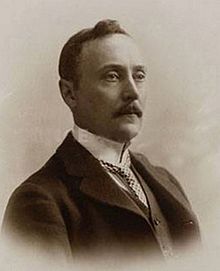William Duddell
William Du Bois Duddell (born July 1, 1872 in London , † November 4, 1917 there ) was an English electrical engineer and inventor.
Life
He was born in London as the son of Frances Kate Du Bois (1852-1931), who was married from 1881 to George Duddell (1821-1887), a landowner from Brighton . He spent most of his youth in Cannes , France . There he attended Stanislas High School. Because of his unstable health, he had to do without attending one of the major schools in England. It is reported about him that his extraordinary talent for building devices and instruments was already evident at the age of four. At this age he is said to have constructed his first machine by installing a clockwork in a toy mouse.
After leaving school, he studied with William Edward Ayrton at the Central Technical College in London and began to deal intensively with electrical engineering. From 1890 to 1893 he completed an apprenticeship with Davey, Paxman and Co in Colchester . In 1893 he further developed the electromagnetic needle oscilloscope invented by André-Eugène Blondel into a string oscilloscope and was able to measure alternating currents with high accuracy and record them in curves. By replacing the iron flake used in Blondel's apparatus with a narrow iron band, about 02 to 0.3 mm thick, he achieved natural frequencies of up to 50,000 Hz.
From 1893 to 1901 he taught at the City and Guilds of London Institute and used their facilities to experiment extensively with electro-physical apparatus and to build his own devices, especially measuring instruments. In addition to his oscillograph, he constructed a thermo-ammeter and a thermo- galvanometer . He achieved his great fame with the "Singing Arc", which he presented on December 13, 1900 in front of the London Institution of Electrical Engineers (IEE). Before Edison received a patent for his incandescent lamp in 1880, carbon arc lamps were popular, especially as the first electric street lights . A disadvantage that stood in the way of an even broader application of the technology was that the arc also produced a clearly audible, mostly very unpleasant, electrostatic hum or hissing sound. Duddell undertook attempts on a public contract to eliminate this hum when he accidentally discovered what is known today as the "Duddell effect", which can be observed by connecting an oscillating circuit in parallel with a coil with high self-induction and a capacitor . The arc can be excited to oscillate, the frequency of which lies in a range that can be perceived by the human ear , so that the test arrangement generates tones that can be heard without amplification by a loudspeaker. The pitch depended on the alternating current frequency in the capacitor circuit. In 1901 he published an important essay on this, which was presented by the Royal Society and which was also published in Germany under the title “On the new effects of the direct current arc”. Duddell added a keyboard and thus constructed one of the first electric musical instruments. In the subsequent very numerous demonstrations of the instrument, he is said to have played the hymn God Save the Queen on it.
The invention of the arc transmitter based on the “singing arc” also originated from himself and not from the Danish inventor Valdemar Poulsen . Duddell constructed a direct current arc transmitter for 120 kHz and various radio measuring devices. For practical use, however, it was only the much more sophisticated design developed by Poulsen that was able to generate undamped vibrations with a frequency of up to 250 kHz.
In 1907 Duddell became President of the British Institute of Radiology . From 1912 to 1914 he was the youngest president of the IEE to date ; he had already been accepted as a member in 1904. In 1906 and 1911, the Royal Institution of Great Britain invited him to give the traditional Christmas lecture. A tradition founded by Michael Faraday in 1825 . Duddel presented the topics "Signaling to a Distance" and "Modern Electricity". The British learned society Royal Society elected him a Fellow in 1907 and awarded him the Hughes Medal in 1912 .
In his honor, the Institute of Physics donated the “Duddell Medal and Prize”, an award given annually or at least every two years to distinguished physicists from 1923 to 2008. From 2008, however, the name was changed to "Gabor Medal and Prize".
literature
- Kurt Jäger (Ed.): Lexicon of electrical engineers , VDE-Verlag, Berlin and Offenbach 1996, ISBN 3-8007-2120-1 . P. 103
Web links
- William Du Bois Duddell ( June 25, 2008 memento on the Internet Archive ), biography on a Clarkson University page
- William Duddell in nndb (English)
Individual evidence
-
^ H. Schering: Schwingungsinstrumenten . In: Apparate and measuring methods for electricity and magnetism , Volume 16 of Handbuch der Physik , Springer Verlag 1927, or as eBook 2013, ISBN 978-3-642-90775-3 . P. 324 f.
( limited preview in Google Book search) -
↑ Milan Vidmar: Lectures on the scientific basics of electrical engineering , Springer Verlag 1928, or as eBook 2013, ISBN 978-3-642-52626-8 . P. 417
( limited preview in Google Book search)
| personal data | |
|---|---|
| SURNAME | Duddell, William |
| ALTERNATIVE NAMES | Duddell, William Du Bois |
| BRIEF DESCRIPTION | English electrical engineer |
| DATE OF BIRTH | July 1, 1872 |
| PLACE OF BIRTH | London |
| DATE OF DEATH | November 4, 1917 |
| Place of death | London |
